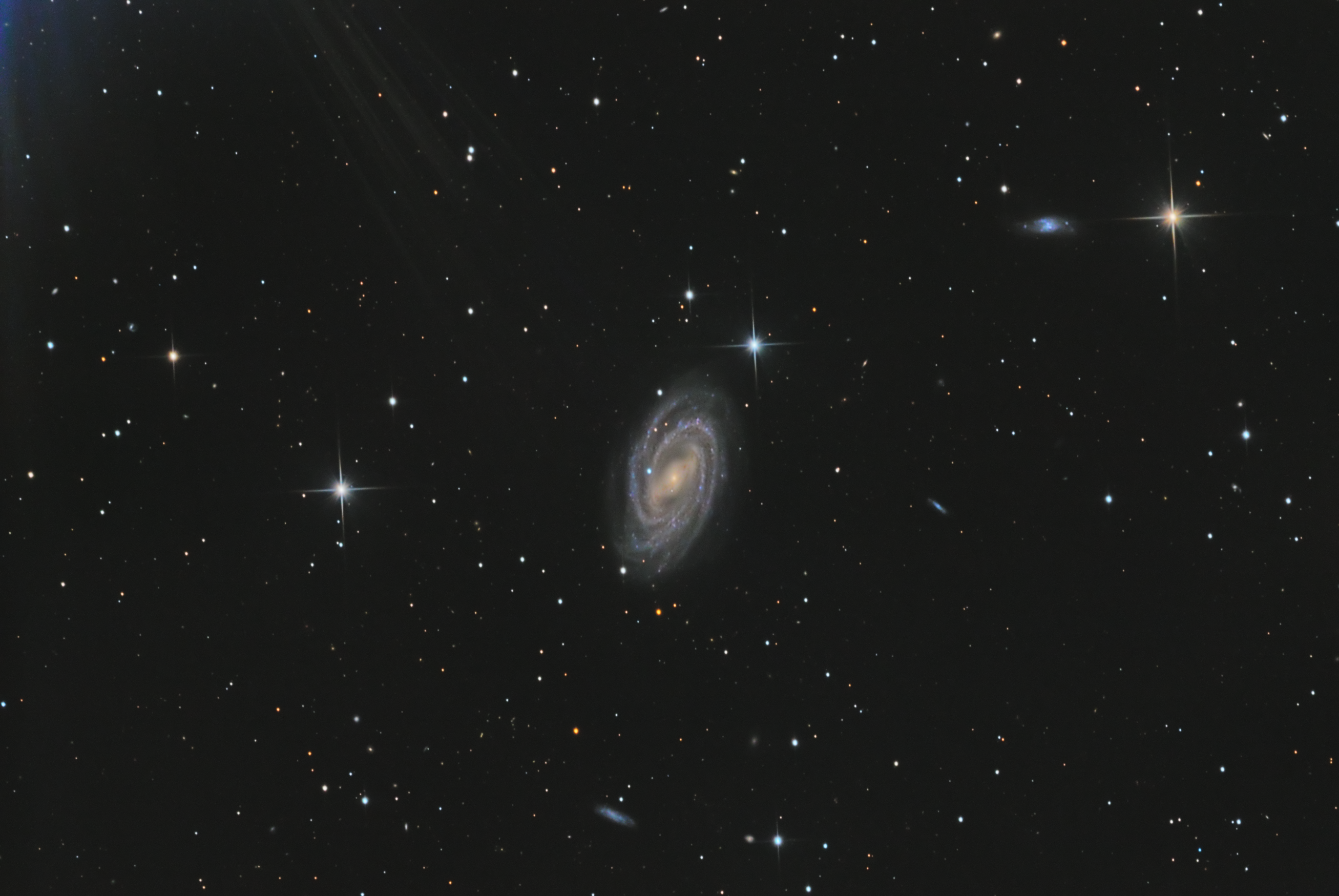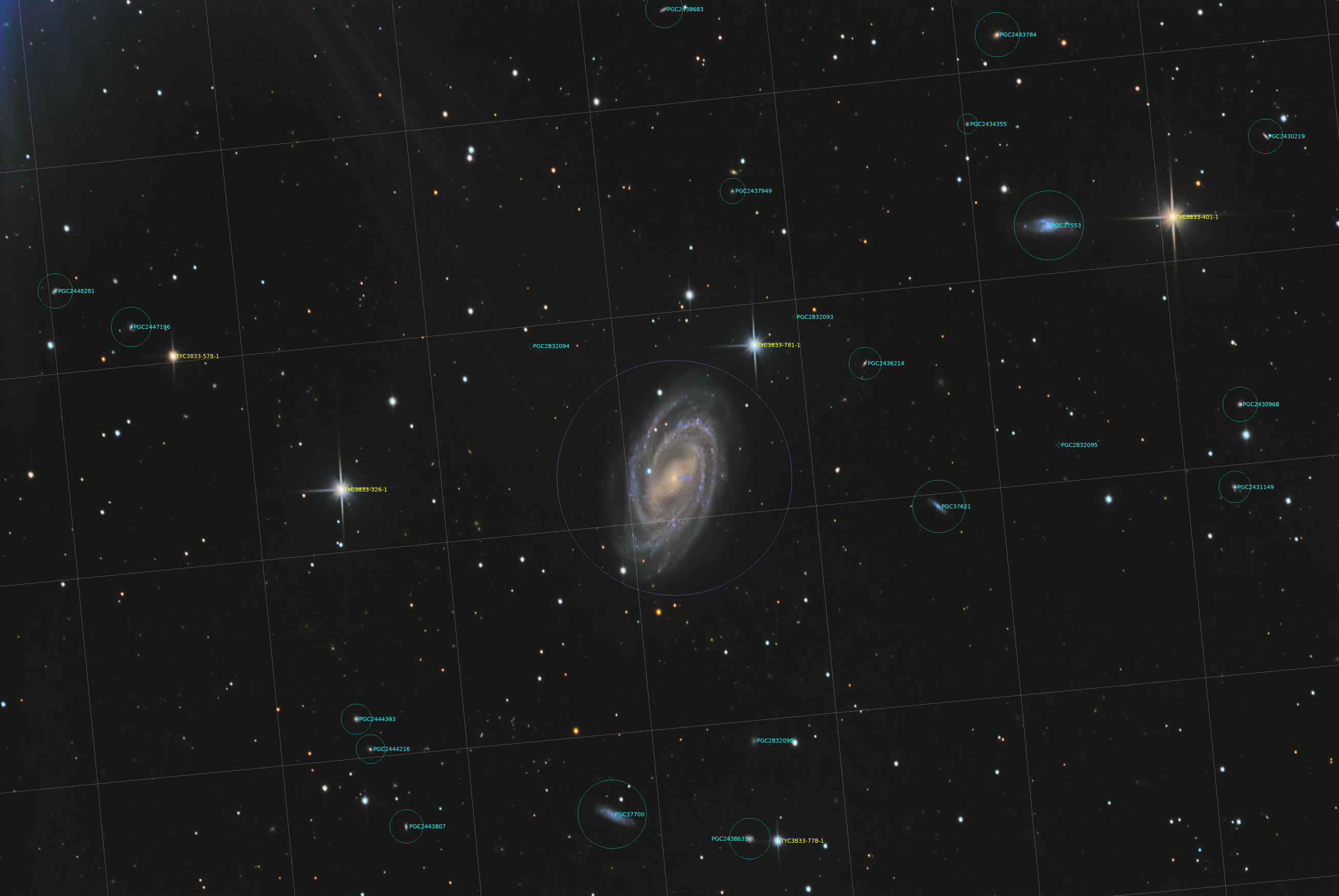
Messier 109 is a Barred Spiral Galaxy that can be spotted next to Phecda, the sixth brightest star in Ursa Major. It’s most notable feature is the long bar going through it’s core that resembles Darth Vader’s Tie Advance star fighter from Star Wars. Nearby in this image are many other more distant galaxies and a few that are satellite galaxies in the M109 Group.
Phecda (outside of frame) is glowing quite brightly from the upper left corner but there can be seen diffraction spikes that just happened to be lined up in such a way that make this image also resemble the Bat Signal or some form of galactic spotlight. :)

Follow Me on Instagram | Astrobin | DarkFlats
Equipment:
Orion 8in F4.9 1000mm Newtonian Reflector
- Flocked / Primary mirror replaced due to turned-down-edge
Sky-Watcher F4 Aplanatic Coma Corrector
Astrodon E Series L, R, G, B broadband filters
Celestron CGEM Mount
Self tuned / hacks to get guiding stable include:
Intentional offset polar alignment so dec always pulses in one direction
Balance “west” heavy (rather than the recommended east) so that the ota “falls” onto the gear teeth rather than get “lifted”
Factory Reset hand-controller daily (to prevent cgem from being possessed and forgetting where the meridian is on subsequent night)
Dither in RA only
8in f4.9 Orion Optical Tube Assembly - 1000mm
ASI183mm Pro cooled to -15C
ZWO OAG + ZWO EFW
Data was acquired across multiple nights between 2020-03-25 and 2020-04-25
| L | R | G | B |
|---|---|---|---|
| 142x120s | 28x120s | 26x120s | 24x120s |
| 4hr 44m | 56min | 52min | 48min |
Total integration time: 7hr 20min
All pre-processing and post-processing was done in PixInsight. Full details below.
The resulting image is a combination of the following steps:
Inspected all subs for bad images with Blink, discarding subs containing clouds
Calibrated all subs with their corresponding master flat and master dark
Used sub-frame selector to weight all images based on the following weighting
1 |
|
Selected the best sub from sub-frame selector and blink to use as a reference frame for aligning and integration
All subs of each filter were aligned to the same reference frame using the Star Alignment process
Integrated all Red frames together, Blue frames together and Green frames together and Luminance frames together to create masters for each color.
Cropped the stacking edges of the integrated masters
[RGB Processing]
Channel combination to combine the integrated Red, Green and Blue frames
Dynamic Background Extraction
Background Neutralization using 4 small preview windows aggregated as a background reference
Color Calibration using m109 as the white reference
Noise Reduction was done using TGVDenoise with a low contrast mask and an auto-stretched local support, SCNR to remove the green overcast and MMT with a very protective luminance mask as documented by Jon Rista An additional round of DBE was used to remove newly discovered color gradients through the noise reduction process.
An initial stretched using Masked Stretch with no clipping and then Histogram Transformation to bring the tail in
Increased the saturation of the image using the C curve in Curves Transformation and a luminance mask
Final round of Masked Stretch to lift the brightness of the image
Increased contrast in the galaxy using a clipped luminance mask and HDR Multiscale Transform targeting the lightness and 6 layers.
The RGB image was placed aside for Luminance Processing Next
[Luminance Processing]
The masters for each filter were re-integrated together using the “L” master as integration reference to produce a synthetic-luminance
No rejection | Median Absolute Deviation from Mean Scale Estimator
Dynamic Background Extraction were applied to remove gradients throughout the field
Deconvolution was done on a separate copy of the luminance with
No deringing
wavelet regularization with 5 layers and strong but reducing amounts/thresholds
A combination of starmask and clone stamp was used to produce a series of star masks that together covered all ringing artifacts produced by deconvolution
Additional sharpening was performed using MultiscaleMedianTransform with six layers increasing bias on layers 2-4 using a clipped luminance mask to protect the low signal areas
Noise Reduction was done using TGVDenoise with a low contrast mask and an auto-stretched local support
The resulting luminance was stretched using Masked Stretch, no clipping, and the same background preview windows aggregated. The tail was brought in using histogram transformation, and the stretch was repeated.
Increased contrast in the galaxy using a clipped luminance mask and HDR Multiscale Transform targeting the lightness and 6 layers.
[Combination and Final Adjustments]
The Luminance and the RGB Image was brought together using the LRGB Combination Tool applying the processed/stretched luminance to the processed/stretched RGB images. Chrominance noise reduction was not enabled on this combination.
The trailing of the star cores was reduced by applying deconvolution using a star mask with deringing
Additional noise reduction was performed on the background regions to permit stretching more of the high signal areas
Large Scale Contrast was increased using Local Histogram Equalization with kernel radius 128 and a small amount
Additional round of HDR Multiscale Transform was used to increase contrast between the galaxy’s barred core and it’s spiral arms
A final round of curves was applied in an attempt to lift the galaxies and stars off of the background sky
An ICC Profile was applied to enable Black Point Compensation
Constructive criticism is welcome. Let me know what you think! How can I improve?